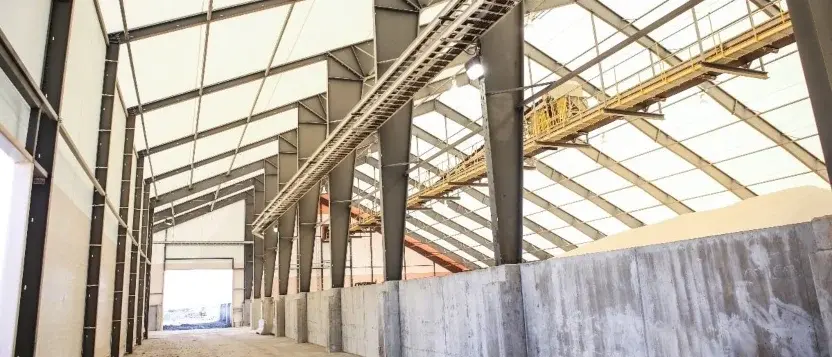Benefits of Steel Rigid Frame Structures for Fabric Buildings

Selecting the right structural system is important for the success of any building project. Rigid frames, open web trusses, and air-supported buildings differ in load capacity and design versatility.
Let's explore how these systems compare with rigid frame structures for durability and efficiency, helping you determine the best fit for your project’s needs.
Open Web Trusses
Open web trusses have tubular web members welded to the top and bottom cords of the truss. This can create stress points and typically produce greater flexing with the truss.
Structural Strength
Open web trusses are lighter but can develop stress under heavy use. One potential structural issue is "chord plastification," where a thin steel web within the truss can puncture the supporting chord, leading to instability or failure. Additionally, the hollow frame components of open web trusses, connected solely by welded steel cords, are prone to internal corrosion in caustic environments.
Efficiency
Open web truss systems can be efficient when produced in larger quantities. However, mass production may restrict customization, capacity, and longevity. Their rounded shape can complicate adding openings along curved walls, often requiring additional engineering efforts for customization.
Design Flexibility:
Given the structural limitations and integrity of open web trusses, they offer limited design and customization options.
Air-Supported Structures
Inflatable buildings, like sports domes or bubbles, are often designed for temporary or seasonal use cases. All fabric requires some type of support, and sports domes use air pressure to keep the dome inflated.
Building Materials
Sports bubbles and frame-supported rigid fabric buildings are constructed of structural fabric, typically polyvinyl chloride (PVC) or polyethylene (PE). The fabric is treated with plasticizers that extend its life and prevent degradation from UV rays, wind, and snow. The fabric itself is also treated to prevent the growth of mold, fungus, and mildew, supporting a longer life and better environment.
Maintenance and Time Loss
When in use, air-supported buildings require extensive maintenance. They must be constantly monitored and inflated. Snow build-up or power outages can cause permanent or temporary damage.
Seasonal sports bubbles must be re-inflated at the beginning of the season, deflated at the end, and then stored. During each assembly and disassembly, the playing field is out of commission for several days while technicians complete the process. This results in lost time costs.
Restrictive Design Features
Bubbles and domes offer no design alternatives. Designers can’t add additional features to the building or designate separate areas to use for a pro shop, spectator seating, or changing rooms. Door options are also limited, to maintain air pressure. And the inflation will not support additional loads from mounted scoreboards, netting, or divider curtains.
Steel Rigid Frame Structures
Steel structures at Legacy are solid steel, tapered, I-beam frames. They are welded together to support our fabric buildings—the fabric itself doesn’t need to support the structure. Steel rigid frame structures offer key benefits: durability, strength, code compliance, and design customizations.
Long Lasting Durability & Supreme Load Capacity
Modern tension fabric buildings use the same proven engineering techniques and structural steel I-beams as traditional construction.
They are designed to last for decades without additional operating or maintenance costs. Damage to the fabric, while rare, is easily repaired by the building owner or by trained crews.
To further reinforce our steel I-beam frame designs, we use secondary framing practices like purlins, flange braces, cross cables, and bracing rods that add to the strength and lifespan of our fabric buildings.
Our buildings withstand Mother Nature and abide by building codes. Our engineering team designs frames to handle strong winds, heavy snow loads, and seismic conditions. We have buildings in northern Alberta, the Andes Mountains, and in ‘hurricane alley’ in Florida.
When you build with rigid steel frames using standardized design software, it’s much easier to abide by local (or international) building codes.
Design Customizations
Because rigid frames are very strong, they can be engineered to support various loads. This means you can add many options to your building, such as cranes, conveyors, and catwalks.
If you plan a sports facility, you can hang scoreboards, backboards, netting, sound systems, and mezzanines from our rigid beams.
Choosing the right structural system depends on your project’s specific needs for load capacity, durability, and flexibility. Rigid frame structures offer unmatched strength for heavy loads, while open web trusses provide a lighter option, though with potential stress points.
Legacy Building Solutions specializes in delivering customized structures that excel in long-term performance, ensuring your project meets its unique needs. Consult Legacy to discover the ideal solution for your next build.
Subscribe to our Blog
Recent Posts
- 5 Factors Every Project Owner Should Consider Before Approving Building Materials
- The 20-Year View: How Material Choices Impact Long-Term Operational Costs
- Climate Resilience in Commercial Construction: Why Traditional Methods May Not Be Enough
- Speed and Quality: The Role of Hybrid Building Materials
- Beyond the Bleachers: Designing Visually Striking Sports Facilities
